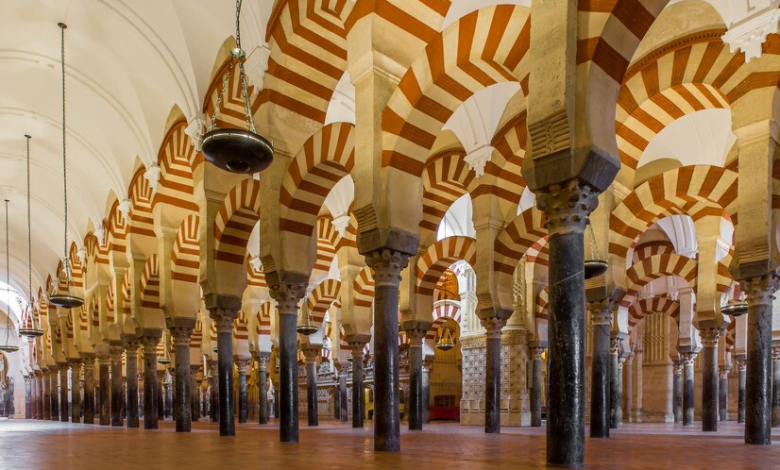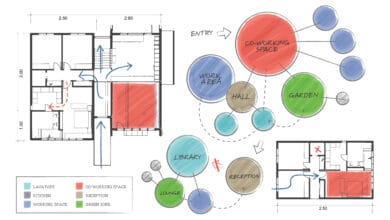Majestic Islamic Architecture in Spain: Top 10 Iconic Places

If you think Spain is only famous for bullfighting and football, you are wrong. Islamic Architecture in Spain is a testament to the rich historical and cultural influences of the Moors in the region. The center of innovation and knowledge, Spain is home to many historical sites that witness the Iberian Peninsula’s eight centuries of Muslim rule. A visit to the region would be complete only by exploring the Islamic and Islamic-influenced structures.
While Christians gradually gained political control over Muslims in medieval Spain, al-Andalus’ cultural influence remained strong. Islamic architectural influence was so widespread that non-Muslims began incorporating it into their religious structures. So today, let us explore some of the Islamic Architecture so that you know exactly where to go during your next visit to Spain.
Islamic Architecture in Spain
Islamic Architecture is part of a more significant movement in Spain that flourished in the Western Mediterranean region, leaving architectural marvels in modern Morocco, Tunisia, Libya, and Algeria. Architecture and art are inextricably linked in Islamic culture. Islamic art reflected the caliph’s status and vast sums were spent on its creation.
Islamic Architecture differs from Christian and Jewish monuments. Moorish art does not directly depict religious icons or humans. Other monotheistic religions encourage representations of the divine, but the Quran prohibits explicit devotions. This makes theological symbols fade away in favor of unique architectural patterns.
History of the Arabic Influence on Spanish
Some people think the Arab influence in Spain was limited to the southern region of Andalucía. However, scholars believe it spread across the Iberian peninsula, which includes Portugal and Spain.
In 711, Arabs arrived in Spain via the Strait of Gibraltar. Spain was originally a set of independent kingdoms. Arabic architecture in Spain conquered the region in seven years, with the occupation ending in 1492.
During the Moorish invasion of Spain, they did not destroy the culture of the territories they occupied. Unlike many of today’s barbarians, conquerors would preserve places, tolerate religions, and absorb cultures.
Most information and ideas were spread via trade routes, of which Arabs had plenty. They were installed principally in southern Spain, also known as Islamic Iberia or “Al Andalus”—today Andalusia.
Top 10 Stunning pieces of Islamic Architecture in Spain
1. Nasrid Palaces- Alhambra
The Alhambra complex in Granada stands as the most iconic example of Muslim influence in Spain Architecture. As the world’s finest Arab palace and one of the most breathtaking monuments, it radiates beauty from every hall and courtyard. The residence of the Nasrid Kingdom became a masterpiece of sensory delight, where harmony, refinement, and intricate decoration reached unparalleled perfection.
2. The Aljafería Palace
Aljafería’s Palace proves that the legacy of Muslim civilization is not reduced only to the south of the Iberian Peninsula. This fortified medieval fortress, which has suffered various modifications throughout its history and now resembles a Christian castle, retains the design and ornamentation of the ancient Muslim Alcazar fortress. The lobed arches, mosque, and courtyard symbolize the Taifa Kingdom’s power. Today, it houses Aragon’s Parliament.
3. Mezquita de Córdoba, or Cathedral
Cordoba has several Arabic architectural masterpieces, but the Mezquita Cathedral is one of the most iconic ones on the list. Construction began in 784, and the mosque has grown in magnificence. Abd al-Rahman I erected 130 columns, marking the start of a massive column expansion. Today, the Mezquita Cathedral is famous for its column forest, which comprises “only” 856 tall and colorful columns.
Abd al-Rahman III then built a minaret for prayers. In addition to that, Al-Hakam II assembled a library of over 40,000 volumes and raised a mihrab within the mosque. The mihrab is known for its intersecting cusped arches, an Islamic architectural style unique to Spain. Finally, following the reconquest, the monument became a well-known church for Christian prayers.
4. Madinat Al-Zahra
Constructed in the 10th century for the Caliph of Córdoba, Madinat al-Zahra is a palace considered one of the most important Islamic buildings in Spain. The Palace was destroyed in the 11th century, but its ruins have been preserved and are now open to the public.
5. La Giralda, Sevilla
La Giralda, the bell tower next to Seville Cathedral, stands as a striking example of Moorish architecture. Visible from afar, its grandeur captivates visitors. Constructed in the late 1100s, the tower features intricate archways, latticework, and simulated balconies, reflecting its inspiration from Morocco’s Koutoubia Mosque. Visitors to La Giralda can ascend to the observation platform, which offers stunning panoramic views of Seville. The surrounding landscape is equally impressive, with Moorish influences seen in the Almohad-style courtyard adorned with orange trees and a serene reflecting pool.
6. Generalife of Granada
The Generalife of Granada is a palace built in the 14th century for the Nasrid rulers of Granada in Al-Andalus. It is known for its beautiful gardens and stunning views of the city. The Palace is a great example of Islamic Architecture, with its intricate carvings and lovely arches. It is a UNESCO World Heritage Site that receives millions of visitors each year.
7. Almonaster la Real Mosque
Almonaster la Real is a hidden gem in Spain, featuring a blend of architectural treasures, including a castle, mosque, Mudejar, and Gothic houses. The mosque, though not the most visually striking monument, offers deep insights into the Moorish period as one of the region’s enduring examples of Islamic Architecture in Spain. Enclosed by fortified walls, it stands as a testament to the area’s rich history.
The town itself exudes a serene beauty, untouched by mass tourism. Strolling around the mosque, with views of the surrounding valleys and the sound of birdsong, is a tranquil experience that makes Almonaster la Real a must-visit destination.
8. Mosque of Cristo de la Luz
Built in the 10th century for Toledo’s Muslim community, the Mosque of Cristo de la Luz stands as one of Spain’s finest examples of Islamic architecture. Its distinctive design beautifully blends Islamic and Christian influences, showcasing the rich cultural interplay of the period.
9. Basharat Mosque
The Basharat Mosque, located in Pedro Abad in the Spanish comarca of Alto Guadalquivir in the province of Córdoba, is one of Spain’s most historically significant mosques. Constructed in 1982, it holds the distinction of being the first purpose-built mosque since the end of Muslim rule in the 15th century. The mosque, featuring two minarets, served as the center of the Ahmadiyya Movement in Spain, sparking considerable attention. Though it may not be widely known, its historical importance is undeniable.
10. Torre del Oro
The Torre del Oro is a tower designed in the 13th century to protect Seville from Moorish attacks. Its intricate brickwork and beautiful arches make it an excellent example of Islamic architecture.
Conclusion
The legacy of Islamic Architecture in Spain dates back to the Middle Ages, during the era of Moorish rule. As the Moors established their presence, they left an indelible mark on the region through the creation of imposing fortifications, majestic mosques, and opulent palaces. Their architectural achievements not only served practical purposes but also embodied the cultural and artistic advancements of their time, enriching Spain’s historical landscape.



